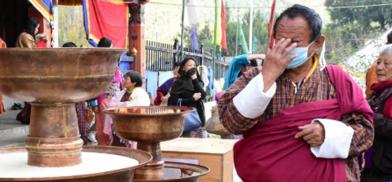Bhutanese complacent despite the spike in COVID-19 cases
The recent spike in the number of COVID-19 positive cases in the country has done little to alarm public who have now returned to ‘business as usual’ after the initial scare

Thimphu: The recent spike in the number of COVID-19 positive cases in the country has done little to alarm public who have now returned to ‘business as usual’ after the initial scare.
Last month recorded 34 positive cases in returnees mainly from the Middle East, with the highest jump of 10 cases within 24 hours on May 30. Even then, it was a usual sight in Thimphu – large crowds strolling the town and the usual large traffic along the Norzin Lam and Paro town.
Worst, people who had just completed the mandatory 21-day quarantine were seen visiting other quarantine facilities.
Health Minister Dechen Wangmo during a press briefing yesterday said that three individuals after completing their quarantine had travelled to Paro to meet their friends, who are currently in quarantine.
From illegal border crossing to entering another person’s room inside quarantine centres and exchanging goods with people inside the facilities (passing in tobacco products), the ministry has found 63 people default on the quarantine protocol. All of them are under quarantine for another 21 days with 10 days of mandatory community service.
With the potential risks associated with people completing quarantine and those recovering from the virus, Lyonpo said that a second layer of surveillance has been initiated. Under this initiative, those completing quarantine and recovering from the virus are constantly monitored for a week by health officials. Currently, there are about 460 people who are under surveillance.
However, the minister said that a more serious threat comes from the border areas as the neighbouring Indian states see an increasing number of cases.
While the entire country remains susceptible to the current pandemic, the level of threat differs from one place to another. Lyonpo said that considering the differentiated risk model, there is more risk in the border areas than in a rural settlement.
“This is why we have stepped up our surveillance at the border with frequent testing in high-risk communities,” she said. Although there are no major changes to the existing preventive efforts, vigilance has increased.
Lyonpo said that all measures put in place are the most effective. Complacency, she said comes from individuals and it’s not the lack of system but the shortfall in following the rules. “We have put in additional preventive measures along the border, and slowly as situation changes, the differentiated risk model will be more pronounced,” she said.
So accordingly, the minister said the current 7pm restriction and movement of people would change.
“Our strategy is simple, if you show me a pistol, I’ll show you my AK-47.”
Beside the COVID-19 risks, the health minister said that the emergence of seasonal diseases like malaria and dengue poses another threat to the public. However, she said that all necessary measures are put in place should there be a major outbreak.
Rising positive cases from abroad
Why do many coming from the Middle East test positive?
Every positive case is scrutinised and investigated by the health team. Lyonpo Dechen Wangmo said that some of the returnees from the Middle East had shown symptoms while they were still in the host country.
“There were people who on their arrival in the country had fever. For these groups and those coming from high-risk countries we conduct the test as soon as they arrive,” Lyonpo said.
There is another group who test positive during the third and fifth-day tests while in the quarantine. The minister said that some of them have shared that while in the Middle East they stayed in a group of more than 30 people.
“Many are infected in this group but they do not know if they are COVID-19 positive as they are not tested.”
She said that the testing facility is not readily available in most countries like it is in Bhutan.
However, to trace where a person is infected (at the airport, in the aircraft or while in the host country), Lyonpo said it would be epidemiologically difficult. “Our number of cases, for now, is very small and it is difficult to come to a conclusion given the small data pool.”
A Bhutanese who had recently returned from Kuwait said that despite the lockdown imposed there, some of the companies where Bhutanese were employed are still operating.
She said that a partial curfew was imposed when the number of cases started to increase and people started buying goods online. “However, to deliver those online orders, the workers had to come to work as usual.”
She added that when the stores were closed, many Bhutanese workers were called to work at the warehouse. “We later learnt that there was a COVID-19 positive person working at the warehouse but none of us was informed about it.”
The minister added that the returnees who test positive for the virus are all asked about their contacts in the host country. The ministry then relays the information to the respective Embassy to follow up with the contacts.
Meanwhile, with the increasing threat from the deteriorating situation in the region, the health ministry has increased its surveillance sites from 11 to 50. All flu-like symptoms would be tested for COVID-19 at these sites. Rapid diagnostic test facilities are available across the country.
An additional testing laboratory to conduct the reverse transcription-polymerase chain reaction (RT-PCR) test in Gelephu would be established. There are three testing centres: the Royal Centre for Disease Control laboratory in Thimphu, Mongar and Phuentsholing hospitals.
https://kuenselonline.com/bhutanese-complacent-despite-the-spike-in-COVID-19-cases/








Post a Comment